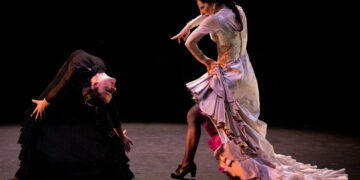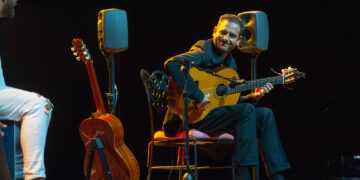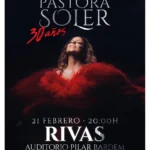|
|
||||||||
|
SPECIAL COVERAGE: BIENAL DE FLAMENCO DE SEVILLA 2010 “PASTORA” PASTORA GALVÁN Text: Estela Zatania Choreography and music director: Israel Galván. Dance: Pastora Galván. Guitar: Ramón Amador. Cante: David Lagos, José Valencia. Compás: Bobote. Just a year and a half ago when I saw this work at the Festival de Jerez, I wrote that Pastora Galván is no longer “the sister of …..”. At this point in time, that simple comment is completely unnecessary: all followers of flamenco dance know exactly who Pastora Galván is, and it’s no exaggeration to say that “Galvanism” has become the “Seville school” of the new millennium. Not because it has displaced the admirable model of intelligent minimalism and elegance of Matilde Coral, Milagros Mengíbar and so many others, but because Pastora and Israel base their work on what has gone before and the teachings of their father José Galván to experiment and go beyond without pulling up roots. The short list of artists with no instruments or cajón augurs well. Like a film samurai, Pastora goes in search of herself with only the basic tools of her trade: dance, guitar and singing, with no embellishment beyond her own genius and creativity…which are considerable. The first “scene” (because Israel, who is credited with the choreography, doesn’t care for the standard format of one dance after another, preferring something closer to “scenes”), continues to be the best part of the show. Elements that go beyond traditional, such as the frumpy housedress and knee-socks, dancing on a living-room rug or the innocently lascivious movements typical of how elders used to dance in the patios of Andalusia, come face to face with the surreal futurist vision of the two Galvans (although Israel is responsible for the choreography, this work would not be possible without the intelligence and personality of Pastora). Two excellent voices back up the dance. The underused David Lagos, and the wonderful José Valencia. But the exceptional guitarist Ramón Amador also does some respectable singing with a taranto he himself accompanies, and Bobote who does the palmas also sings a little bit of tangos. Generally speaking, the cante is given more autonomy than it is usually afforded in the presence of dance, and much of it without musical accompaniment. The singing is danced to or not, regardless of the need to kill time for a change of costume. The pattern of breaking patterns continues to be Galvanically current. There’s siguiriyas, there’s solea, there’s marianas, pregones, but at all times the form is secondary to the subtly oneiric atmosphere. The most complete dance, in the conventional sense, is alegrías, classic in almost every way (it’s not the first time a dancer with bata de cola has stood atop a chair, but it’s not your standard choreography either), where we can admire Pastora’s excellent preparation. Towards the end, the format of scenes became fragmented into brief, seemingly disconnected sketches which had a coherence of their own. A bit of alboreá, bulería romanceada, sevillanas like you’ve never seem them before, subtle humor, unexpected contrasts, Pastora seated in profile singing bulerías for Bobote’s dance, a pass of sevillanas between the two just to remind everyone we’re on the banks of the Guadalquivir… All in all, a fascinating mix of conceptual and traditional dance destined to open the mind of even the most intransigent hard-liner. “CONCUERDA” SANTIAGO LARA Text: Estela Zatania Guitar: Santiago Lara. Percussion: Perico Navarro. Cante: Londro. Palmas and chorus: Javier Peña. Piano and keyboard: Miguel López. Guest dancer: Mercedes Ruiz. A refreshing alegrías composition was Santiago Lara’s choice to open his guitar recital at the Teatro Alameda with the dramatic appearance of dancer Mercedes Ruiz in a white satin bata de cola. Mercedes upstaged the guitarist, but it was a happy distribution of powers. I remember the concerts of Sabicas about 45 years ago; a man and his guitar, and that was it. But flamenco times have changed. Like it or not, then as now instrumental flamenco can be excellent music, but it cannot be more than an evocation of flamenco. Lara incorporates so many moments of cante and dance, if you don’t look at the program “Concuerda” almost seems like your typical flamenco show…and that’s not a complaint! In fact, I think it’s great, because there is ample opportunity to appreciate the artistry, creativity and capacity of this young guitarist. There is also a pianist, Miguel López, percussion handled by Perico Navarro, chorus and palmas by Javier Peña and the cante of Londro. After the alegrías, Santiago addressed the audience and explained how pleased he was to finally be playing at the Bienal. He went on to play taranta with wisely employed contemporary harmony that left the peculiar flavor of the Levante intact. The same discreet innovation worked well for farruca, elegantly danced by Mercedes wearing a black trouser outfit and delivering the Carmen Amaya details she likes to employ. The program included a kind of tango-rumba with piano, granaína, siguiriyas taken at a clip and with dance, fandangos with cante, a danced bulería por soleá, bulerías…. A wide variety of pieces interpreted with the intelligent exuberance of this couple Lara/Ruiz who were rewarded with the audience’s enthusiastic ovation. |
Descubre más desde Revista DeFlamenco.com
Suscríbete y recibe las últimas entradas en tu correo electrónico.


































